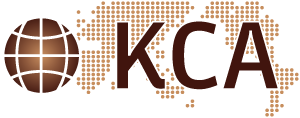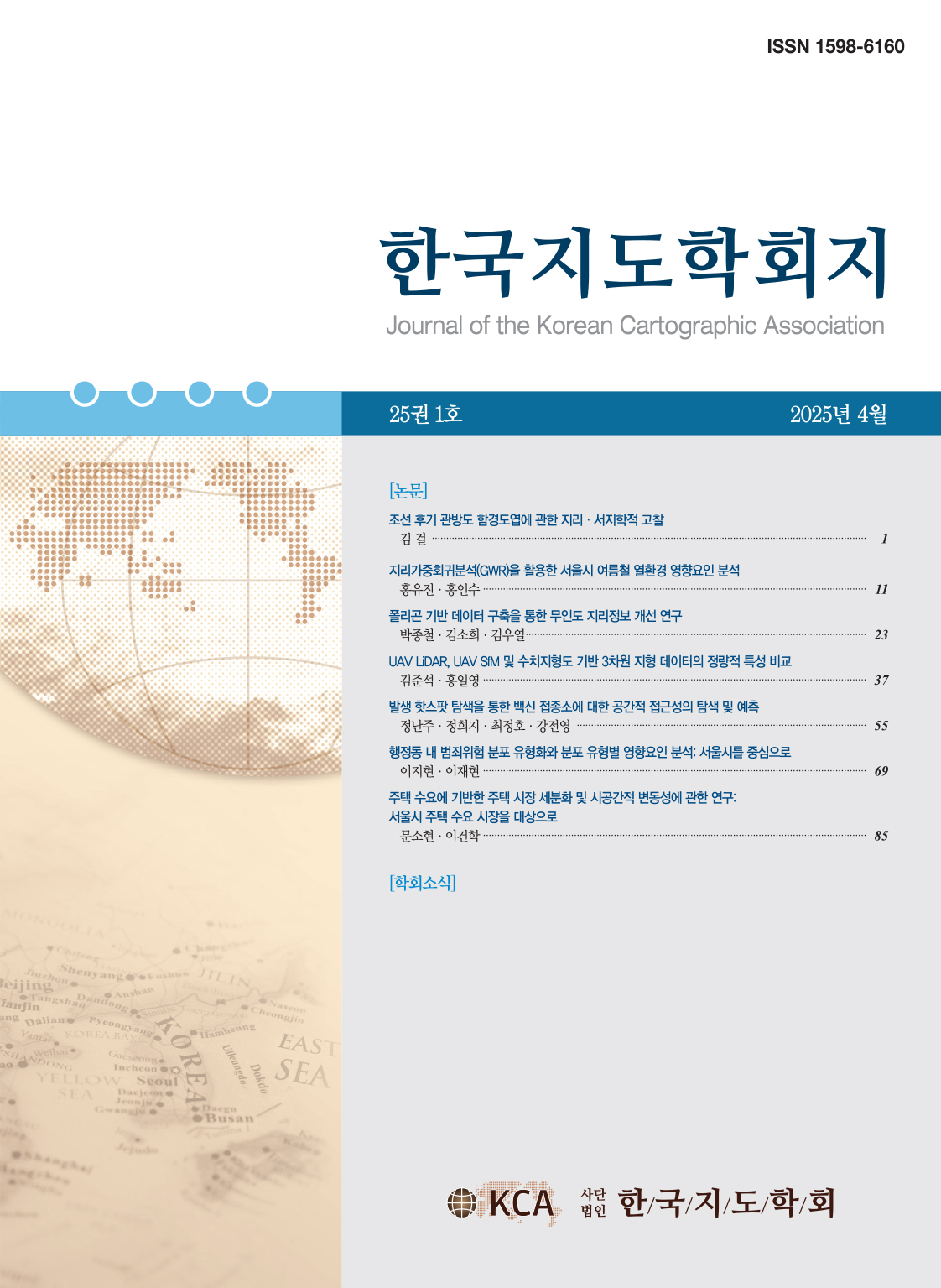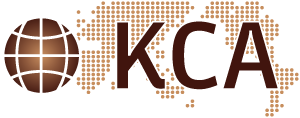Research Article
Abstract
References
Information
This study analyzes the spatiotemporal changes of bus network clusters before and after COVID-19 with the purpose of exploring areas with high potential for the spread of infectious diseases. As the analysis method, the Gij statistic was used, which is an extension of the Getis and Ord Gi statistic to spatial network framework. Since statistical calculation is applied for individual flows in the bus transportation network, a parallel computing method and a supercomputer hardware are applied for the large-scale operations. The result is as follows: First, bus flows in networks are concentrated in limited places during COVID-19. Second, during COVID-19, bus uses to residential and agricultural areas increased, and bus uses to commercial and transportation areas decreased. Third, unlike other CBD clusters, no significant changes were observed in bus flow in Gangnam before and during COVID-19. This study presents the first analysis and identification of bus network cluster before and during COVID-19 in Korea.
이 연구는 전염병의 잠재적 확산 가능성이 높은 지역의 탐색을 목적으로, 코로나19 전후의 버스 네트워크 클러스터의 시공간적 변화를 분석한다. 분석방법으로는 Getis와 Ord의 Gi 통계를 공간 네트워크로 확장 및 적용한 Gij 통계 값을 사용하였다. 이 과정은 서울시 전체 버스 네트워크의 개별 흐름에 대해 각각 적용되기 때문에 대규모 연산을 위해 병렬컴퓨팅 방식을 적용한 슈퍼컴퓨터를 사용하였다. 연구 결과, 첫째, 코로나19 이후 버스 네트워크가 일부 흐름으로 집중된 경향을 보였다. 둘째, 코로나19이후의 버스 흐름은 주거지, 농업지로의 이동은 증가하고 상업지역, 교통지역으로의 이동은 감소했음을 확인하였다. 셋째, 중심업무지구 중 여의도 방면의 클러스터, 구로디지털단지역 방면의 클러스터와 달리, 강남일대는 코로나19 전후의 유의미한 변화가 나타나지 않았다. 이 연구는 국내에서 처음으로 코로나19전후의 버스 네트워크 클러스터를 확인하고 변화 특징을 제시한다는 의미가 있다.
- 김영롱・윤메솔・이혜령, 2021, 「빅데이터를 이용한 코로나 시대 수도권 유동인구 네트워크 분석」, 수원: 경기연구원.
- 김영호, 2010, “서울시 자전거 이용의 공간 네트워크 패턴 연구: 공간적 네트워크 자기상관을 중심으로,” 국토지리학회지, 44, 339-352.
- 김영호, 2012, “AMOEBA 기법을 응용한 서울시 자전거 네트워크의 클러스터 분석,” 한국도시지리학회지, 15, 77-87.
- 빈미영・손슬기・조창현, 2021, “코로나 19 영향에 따른 정류소기반 버스승하차 통행량변화의 지역적 특성분석,” 대한교통학회지 39(4), 447-463. 10.7470/jkst.2021.39.4.447
- 이만호・이종훈・윤호선・손의영, 2019, “정류소별 영향권 및 접근거리를 반영한 버스 통행배정 신뢰성 향상 방안 연구,” 서울도시연구, 20, 79-90.
- 임창민・김영호, 2016, “아이겐벡터 공간필터링 모형을 활용한 국내 결핵발생의 사회・환경적 결정 요인 분석,” 한국지도학회지, 16, 89-101. 10.16879/jkca.2016.16.3.089
- 정고은・김영호, 2021, “CA(Cellular Automata)와 ARD (Automatic Rule Detection)를 이용한 제주도 도시 스프롤의 시공간적 변화 예측 모델링,” 한국지리학회지, 10, 139-152. 10.25202/JAKG.10.1.9
- 조성진・이규일・윤승호・문성국・김현명, 2019, “대중교통 접근성 분석에 있어서 가변적 공간단위 문제,” 대한교통학회지, 37(6), 499-513. 10.7470/jkst.2019.37.6.499
- 최창락・김예린・홍성연, 2018, “클라우드 컴퓨팅 기반 공간분석의 연산 효율성 분석,” 한국지리정보학회지, 21(4), 119-131. 10.11108/kagis.2018.21.4.119
- 하은혜・이채현・고민경・김감영, 2021, “모빌리티에 대한 COVID-19의 차별적 영향,” 한국지도학회지, 21(3), 59-76. 10.16879/jkca.2021.21.3.059
- Arellana, J., Márquez, L., and Cantillo, V., 2020, COVID-19 outbreak in Colombia: An analysis of its impacts on transport systems,
Journal of Advanced Transportation , 2020, 1-16. 10.1155/2020/886731 - Berglund, S. and Karlström, A., 1999, Identifying local spatial association in flow data,
Journal of Geographical Systems , 1, 219-236. 10.1007/s101090050013 - Black, W.R., 1992, Network autocorrelation in transport network and flow systems,
Geographical Analysis , 24, 207-222. 10.1111/j.1538-4632.1992.tb00262.x - Browne, A., St-Onge Ahmad, S., Beck, C.R., and Nguyen-Van-Tam, J.S., 2016, The roles of transportation and transportation hubs in the propagation of influenza and coronaviruses: A systematic review,
Journal of Travel Medicine , 23(1), tav002. 10.1093/jtm/tav002 - Carteni, A., Di Francesco, L., and Martino, M., 2021, The role of transport accessibility within the spread of the Coronavirus pandemic in Italy,
Safety Science , 133, 104999. 10.1016/j.ssci.2020.104999 - Chang, S., Pierson, E., Koh, P.W., Gerardin, J., Redbird, B., Grusky, D., and Leskovec, J., 2021, Mobility network models of COVID-19 explain inequities and inform reopening,
Nature , 589, 82-87. 10.1038/s41586-020-2923-3 - Chen, Z.L., Zhang, Q., Lu, Y., Guo, Z.M., Zhang, X., Zhang, W.J., Guo, C., Liao, C.H., Li, Q.L., Han, X.H., and Lu, J.H., 2020, Distribution of the COVID-19 epidemic and correlation with population emigration from Wuhan, China,
Chinese Medical Journal , 133(9), 1044-1050. 10.1097/cm9.0000000000000782 - Chun, Y., 2008, Modeling network autocorrelation within migration flows by eigenvector spatial filtering,
Journal of Geographical Systems , 10, 317-344. 10.1007/s10109-008-0068-2 - Engle, S., Stromme, J., and Zhou, A., 2020. Staying at Home: Mobility Effects of COVID-19,
SSRN Electronic Journal . 10.2139/ssrn.3565703 - Flaxman, S., Mishra, S., Gandy, A., Unwin, H.J.T., Mellan, T.A., Coupland, H., Whittaker, C., Zhu, H., Berah, T., and Eaton, J.W., 2020, Estimating the effects of non-pharmaceutical interventions on COVID-19 in Europe,
Nature , 584, 257-261. 10.1038/s41586-020-2405-7 - Goscé, L. and Johansson, A., 2018, Analysing the link between public transport use and airborne transmission: mobility and contagion in the London underground,
Environmental Health , 17, 84. 10.1186/s12940-018-0427-5 - Haushofer, J. and Metcalf, C.J.E., 2020, Which interventions work best in a pandemic?,
Science , 368(6495), 1063-1065. 10.1126/science.abb6144 - Hiscott, J., Alexandridi, M., Muscolini, M., Tassone, E., Palermo, E., Soultsioti, M., and Zevini, A., 2020, The global impact of the coronavirus pandemic,
Cytokine & Growth Factor Reviews , 53, 1-9. 10.1016/j.cytogfr.2020.05.010 - Lee, H., Park, S.J., Lee, G.R., Kim, J.E., Lee, J.H., Jung, Y., and Nam, E.W., 2020. The relationship between trends in COVID-19 prevalence and traffic levels in South Korea,
Int J Infect Dis , 96, 399-407. 10.1016/j.ijid.2020.05.031 - LeSage, J.P. and Pace, R.K., 2008, Spatial econometric modeling of origin-destination flows,
Journal of Regional Science , 48, 941-967. 10.1111/j.1467-9787.2008.00573.x - Malik, Y.S., Kumar, N., Sircar, S., Kaushik, R., Bhat, S., Dhama, K., Gupta, P., Goyal, K., Singh, M.P., Ghoshal, U., El Zowalaty, M.E., O. R, V., Yatoo, M.I., Tiwari, R., Pathak, M., Patel, S.K., Sah, R., Rodriguez-Morales, A.J., Ganesh, B., Kumar, P., and Singh, R.K., 2020, Coronavirus disease pandemic (COVID-19): Challenges and a global perspective,
Pathogens , 9, 519. 10.3390/pathogens9070519 - Mogaji, E., 2020, Impact of COVID-19 on transportation in Lagos, Nigeria,
Transportation research interdisciplinary perspectives , 6, 100154. 10.1016/j.trip.2020.100154 - Müller, S.A., Balmer, M., Neumann, A., and Nagel, K., 2020, Mobility traces and spreading of COVID-19,
medRxiv , 10.1101/2020.03.27.20045302 - Musselwhite, C., Avineri, E., and Susilo, Y., 2020, Editorial JTH 16-The Coronavirus Disease COVID-19 and implications for transport and health,
Journal of Transport & Health , 16: 100853-100853. 10.1016/j.jth.2020.100853 - Nouvellet, P., Bhatia, S., Cori, A., Ainslie, K.E.C., Baguelin, M., Bhatt, S., Boonyasiri, A., Brazeau, N.F., Cattarino, L., Cooper, L.V., Coupland, H., Cucunuba, Z.M., Cuomo-Dannenburg, G., Dighe, A., Djaafara, B.A., Dorigatti, I., Eales, O.D., van Elsland, S.L., Nascimento, F.F., FitzJohn, R.G., Gaythorpe, K.A.M., Geidelberg, L., Green, W.D., Hamlet, A., Hauck, K., Hinsley, W., Imai, N., Jeffrey, B., Knock, E., Laydon, D.J., Lees, J.A., Mangal, T., Mellan, T.A., Nedjati-Gilani, G., Parag, K.V., Pons-Salort, M., Ragonnet-Cronin, M., Riley, S., Unwin, H.J.T., Verity, R., Vollmer, M.A.C., Volz, E., Walker, P.G.T., Walters, C.E., Wang, H., Watson, O.J., Whittaker, C., Whittles, L.K., Xi, X., Ferguson, N.M., and Donnelly, C.A., 2021. Reduction in mobility and COVID-19 transmission,
Nature Communications , 12, 1090. 10.1038/s41467-021-21358-2 - Ord, J.K. and Getis, A., 1995, Local spatial autocorrelation statistics: distributional issues and an application,
Geographical Analysis , 27, 286-306. 10.1111/j.1538-4632.1995.tb00912.x - Schlosser, F., Maier, B.F., Jack, O., Hinrichs, D., Zachariae, A., and Brockmann, D., 2020, COVID-19 lockdown induces disease-mitigating structural changes in mobility networks,
Proceedings of the National Academy of Sciences , 117, 32883-32890. 10.1073/pnas.2012326117 - Tao, R. and Thill, J.C., 2016, Spatial cluster detection in spatial flow data,
Geographical Analysis , 48, 355-372. 10.1111/gean.12100 - Efron, B. and Tibshirani, R.J., 1993, An introduction to the bootstrap, New York: Chapman & Hall. 10.1007/978-1-4899-4541-9
- Tibshirani, R.J. and Efron, B., 1993, An introduction to the bootstrap,
Monographs on Statistics and Applied Probability , 57, 1-436. 10.1007/978-1-4899-4541-9_1 - Templ, M., 2016,
Simulation for data science with R , Packt Publishing Ltd. - Wielechowski, M., Czech, K., and Grzęda, Ł., 2020, Decline in mobility: Public transport in Poland in the time of the COVID-19 pandemic,
Economies , 8, 78. 10.3390/economies8040078 - Yechezkel, M., Weiss, A., Rejwan, I., Shahmoon, E., Ben-Gal, S., and Yamin, D., 2021, Human mobility and poverty as key drivers of COVID-19 transmission and control,
BMC Public Health , 21, 596. 10.1186/s12889-021-10561-x - Zheng, R., Xu, Y., Wang, W., Ning, G., and Bi, Y., 2020, Spatial transmission of COVID-19 via public and private transportation in China,
Travel Medicine and Infectious Disease , 34, 101626. 10.1016/j.tmaid.2020.101626 - CDC, 2021, How Coronavirus Spreads, https://www.cdc.gov/coronavirus/2019-ncov/prevent-getting-sick/how-covid-spreads.html
- 서울시교통정보, https://topis.seoul.go.kr
- Publisher :The Korean Cartographic Association
- Publisher(Ko) :한국지도학회
- Journal Title :Journal of the Korean Cartographic Association
- Journal Title(Ko) :한국지도학회지
- Volume : 22
- No :1
- Pages :35-52
- DOI :https://doi.org/10.16879/jkca.2022.22.1.035



 Journal of the Korean Cartographic Association
Journal of the Korean Cartographic Association





